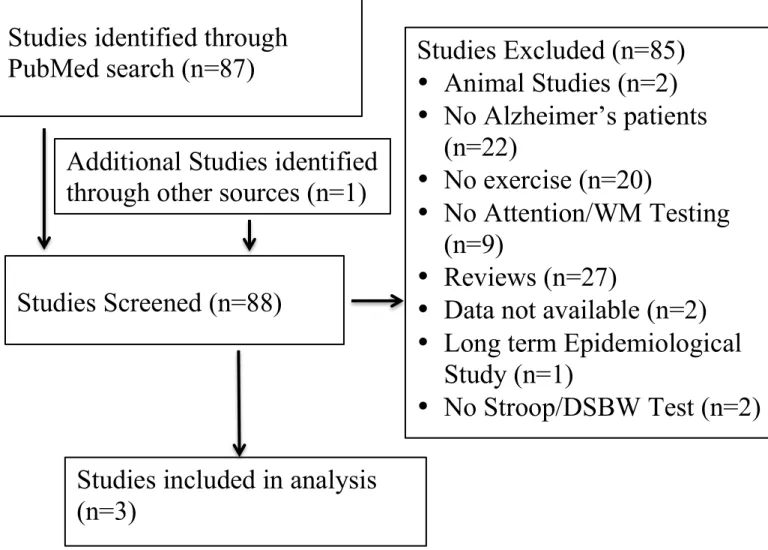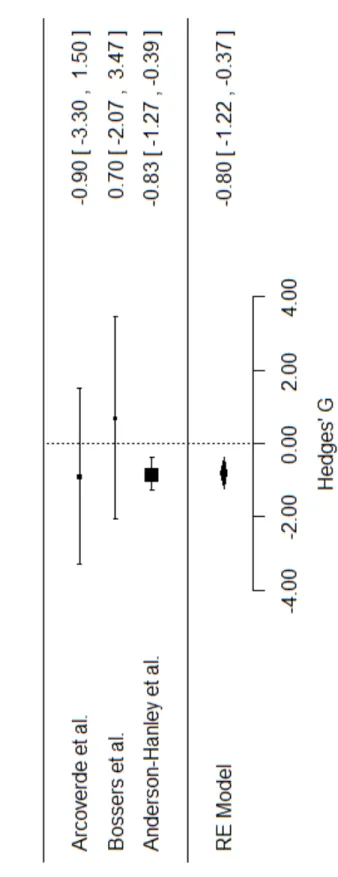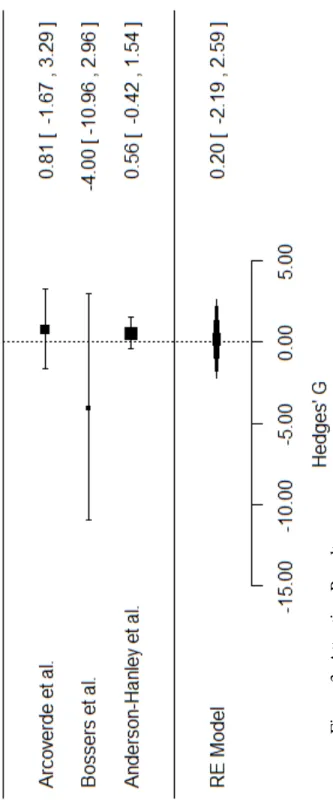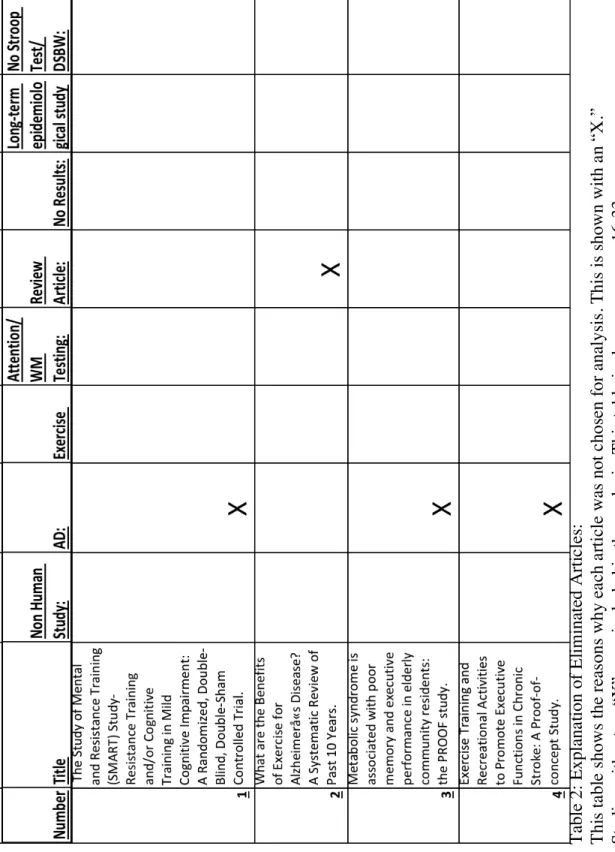SYSTEMATIC REVIEW AND META-ANALYSIS OF EXERCISE EFFECTS ON ATTENTION AND WORKING MEMORY IN ALZHEIMER'S DISEASE
by:
Alexandria Renee Drakos
A thesis submitted to the faculty of The University of Mississippi in partial fulfillment of the requirements of the Sally McDonnell Barksdale Honors College.
Oxford May 2015
Approved By:
Advisor: Toshikazu Ikuta, PhD
Reader: Paul Loprinzi, PhD
Reader: John Rimoldi, PhD
ii
© 2015
Alexandria Renee Drakos ALL RIGHTS RESERVED
ACKNOWLEDGMENTS:
I would like to thank my advisor, Dr. Toshikazu Ikuta, for taking time to work with me during this study. Thank you for all your help throughout this process.
I would also like to thank my readers, Dr. Paul Loprinzi and Dr. John Rimoldi, for taking time out of your schedules to help with this process, as well.
I would also like to thank the Sally McDonnell Barksdale Honors College for giving me this opportunity.
iv ABSTRACT:
Studies have shown that exercise can have positive affects on cognition levels in patients suffering from Alzheimer’s disease. A meta-analysis was conducted to see if exercise had an effect on attention or working memory in patients with Alzheimer’s disease. A search was conducted through PubMed. From the initial search, 87 articles were found. Of these 87 articles, 2 met the criteria for analysis along with 1 additional article found from an additional source. These 3 articles were studied and a meta-analysis was performed. The Stroop Test was used to study attention scores and the Digit Span Test Backward test was used to study working memory scores. The analysis showed a decline in working memory with exercise. A slight improvement was seen in attention scores, but the results were statistically insignificant. The decline in WM might be more closely associated to the progression of the disease in participants, rather than the effect of exercise on working memory of patients. More studies should be conducted in order to further investigate these results.
TABLE OF CONTENTS:
LIST OF TABLES……….………....vi
LIST OF ABBREVIATIONS. ……….vii
INTRODUCTION……….………..……1
MATERIALS AND METHODS……….………...5
RESULTS……….……….………..6
DISCUSSION……….…………7
LIST OF REFERENCES……….………...……9
vi
LIST OF TABLES AND FIGURES:
Table 1: Articles included in meta-analysis. ………12
Figure 1: Flow diagram for identification of eligible studies……….13
Figure 2: Working Memory Results……….………..14
Figure 3: Attention Results……….15 Table 2: Explanation of Eliminated Articles………...…...…..16-33
LIST OF ABBREVIATIONS:
AD Alzheimer’s Disease
BDNF Brain-derived Neurotrophic Factor DSBW Digit-Span Test Backwards
WM Working Memory
MCI Mild Cognitive Impairment
BW Backwards
1
INTRODUCTION
Alzheimer’s disease is a devastating neurological disease, which affects many people throughout the United States and the world. This disease induces a heavy burden on patients suffering from the disease, as well as their caregivers and families. It is a progressive disease that affects areas of the brain responsible for memory. The main areas of the brain affected in Alzheimer’s patients are the hippocampus as well as other parts of the temporal lobe15. Mild Alzheimer’s starts with memory loss associated with accumulation of beta-amyloid plaques outside neurons and tau protein deposits inside neurons in the brain16. The beta-amyloid plaques interrupt the ability of neurons to communicate to each other16. The tau proteins inside cells disrupt the electrical flow of signals in neurons and ultimately cause the death of cells16. As the disease progresses, memory loss becomes more severe and other symptoms develop as well including impaired reasoning and emotional instability15.
In 2013 an estimated 5 million senior citizens, 65 years and older, were living with Alzheimer’s disease in America1. With a growing overall population and an aging baby boomer population, the cases of Alzheimer’s present in the United States are expected to increase dramatically1. According to one study the number of people with Alzheimer’s could potentially rise to 14 million by the year 20501. In 2010, the estimated cost of dementia in the United States was between $157 billion and $215 billion2.
Medicare only covered $11 billion of this cost2. The number of Alzheimer’s cases are expected to increase; therefore, the cost of the disease is expected to at least double or possibly more by 20402. According to one study done by Brookmeyer and colleagues, if the onset of the disease could be delayed by 1 year, it might be possible to reduce the number of new cases by 9.2 million by the year 20504,9. Alzheimer’s is the most common neurodegenerative disease in the United States, and the sixth leading cause of death in the United States17. In recent years there have been many studies showing promising results in Alzheimer’s patients who participate in physical activity programs.
There have been many studies testing the effect that exercise has on patients with cognitive impairments including mild cognitive impairment, Alzheimer’s disease, and dementia. In some of these cases, exercise has been shown to increase cognitive abilities and have a positive effect on overall cognition3, 4, 6, 17
. Exercise has been shown to have results such as decrease in heart disease, decrease incidence of cancer, decreased risk of diabetes mellitus, and decreased development of osteoporosis3. Studies have also shown that physical activity might delay cognitive impairments in patients at risk for cognitive loss3. If exercise is found to delay the effects of cognitive impairment, then it is possible that at risk patients could delay the onset of Alzheimer’s and dementia with a
participation in an exercise program. This would be a huge advance for not only people with Alzheimer’s disease, but also people at risk for developing the disease.
There are several possible reasons why exercise might be potentially protective against cognitive loss. A meta-analysis of exercise on brain-derived neurotrophic factor (BDNF) showed an increase in this protein with participation in exercise programs6. This protein has been linked to neural functioning and development 6, 8. The mechanism
3
for the potential effects of physical activity on cognitive function may be due to increase cerebral blood flow in the presence of physical activity7. Physical Activity may also increase cerebral nutrient supply and increase aerobic capacity7. Due to the positive effects of physical activity, it might be possible to increase cognitive abilities and decrease cognitive decline. Unfortunately, many senior citizens are generally less active than younger adults 19. This could be due to a number of reasons some of which could include disability, no ability to access a workout facility, not learning how to be active, among many others. Even the senior citizens who are active and able to exercise are more than likely participating in lower intensity workouts compared to other younger adults19. While this is due mostly to the natural aging process, this is a significant disadvantage for senior citizens.
In order to test the validity of these results a meta-analysis was performed on published articles meeting the criteria for analysis. The results of these articles were studied. A systematic review and meta-analysis of these studies were conducted to determine if exercise had an effect on attention and working memory in Alzheimer’s patients.
MATERIALS AND METHODS
In order to establish which studies were suitable for the meta-analysis, a PubMed search was conducted on December 15, 2014. The terms searched were
[(((alzheimer[Title/Abstract]) OR dementia[Title/Abstract]) AND exercise) AND attention]. The first studies to be excluded were non-human studies. Following this, studies not including Alzheimer’s patients were excluded. Next, articles not testing exercise were excluded. Then, articles not testing attention were eliminated. Following this step any review articles or articles without results were eliminated. One article was eliminated because it was a long-term epidemiological study. From the remaining articles, any article that included both a Stroop Test and a Digit Span test run backwards were selected for analysis. One additional article was found using an alternate resource.
This process is shown in figure 1. Table 2 shows the title of each article that was found in the PubMed search, and the reason they were not chosen for the analysis.
5 RESULTS
The following results were obtained from the meta-analysis of the 3 articles meeting the specific criteria for the study. For the Stroop Test, meta-analysis did not show significant change in Stroop performance. It showed a slight improvement in attention scores, but the improvement was not significant. For the Digit span BW Test, meta-analysis actually showed a decline in Digit Span performance and working memory. The p value was equal to 0.0002, and the effect size was-0.80 with a 95%
confidence interval of -1.22 to -0.37. Results from the working memory study are shown in figure 2. Results from the attention study are shown in figure 3. Some missing values from the studies were estimated.
DISCUSSION:
This meta-analysis was conducted using the metaphor R package21. The effects sizes for the studies were calculated using random effects model, in which effect size is found under the assumption that the samples were collected from non-homogeneous populations20. From the initial search, 87 articles were found. Of these 87 articles, 2 met the criteria for analysis along with 1 additional article found from additional source.
These 3 articles were used the in meta-analysis. According to the results, exercise had adverse effects on working memory. Exercise showed a slight improvement in attention scores, but the results were statistically insignificant. According to the meta-analysis DSBW showed a decline in performance, reflecting a decline in working memory. In another meta-analysis, exercise was found to also have no significant effect on working memory17. Figure 3 shows the results from the DSBW and working memory. Of the studies included only 1 showed an increase in WM. Figure 4 shows the results of the Stroop Test and attention. Two of the 3 studies showed an increase in attention.
However, these improvements were only slight. According to the results, exercise has no significant effect on attention, and exercise shows a decline in working memory.
The three studies included in the analysis all contained results from the Stroop Test and Digit Span Test Backward. The Stroop Test involves a series of color names written in either the color they represent, or a different color. The subject is supposed to
7
say the name of the color, without reading the word. For example, if the word green was written in the color red, the participate is suppose to say the word “red.” This test is often difficult because the subject has to reject the automatic response to read the word, which can cause a delay in their response5. This delay is known as the “Stroop effect”5. This test was used to measure attention of patients in the studies used in the analysis 10, 11, 12. When testing the working memory of the participates, the Digit Span Test Backwards was used. This test shows the participant a series of numbers. The subject must then repeat the numbers back, but in the reverse order in which they were shown the
numbers18. For example, the participant would hear “1, 2, 3.” The participant would then say back, “3, 2, 1.” This test measures working memory in subjects. The three studies included in this analysis all used these tests in their experiments.
The articles examined in their paper were published between 2012 and 2014, which shows this data was relatively recent and still relevant. The study done by
Arcoverde and colleagues lasted 16 weeks with 10 participants in the experimental group.
It was published in 2013. The exercise, or experimental group, completed a walking program on the treadmill 30 minutes, 2 times a week. The study done by Bossers and colleagues was published in 2014. The studied lasted 6 weeks, and had 18 participants in the experimental group. The participants in the experimental group completed a walking and strength training session. They did 3 walking sessions a week and 2 strength training sessions a week. The final study done by Anderson-Hanley and colleagues was
completed in 2012. The study was 90 days long and included 41 people in the experimental group. The exercise in this study included control bike.
The results indicated a decline in WM. This was suspected to be due to the
progression of the disease in participants, rather than the effect of exercise on the working memory of participants. One limitation of this analysis was the limited number of studies available meeting the criteria for analysis. If more studies were available, the results might have been altered. More studies need to be conducted in order to further investigate these results. An interesting area to further investigate would be to test if exercise has an effect on patients with MCI. These patients are at risk for developing Alzheimer’s disease in the future17. Further studies might show exercise is more effective at preventing the disease, rather than reversing the effects of the disease.
9
LIST OF REFERENCES
1. Hebert LE, Weuve J, Scherr PA, Evans DL. Alzheimer disease in the United States (2010–2050) estimated using the 2010 census. Neurology. 2013;80:1778- 83.
2. Hurd MD, Martorell P, Delavande A, Mullen KJ, Langa KM. Monetary costs of dementia in the United States. NEJM. 2013;368(14):1326-34.
3. Laurin D, Verreault R, Lindsay J, MacPherson K, Rockwood K. Physical activity and risk of cognitive impairment and dementia in elderly persons. Arch Neurol.
2001;58(3):498–504.
4. Liu-Ambrose T, Donaldson MG (2009) Exercise and cognition in older adults: Is there a role for resistance training programmes? Br J Sports Med 43: 25–27.
5. Nombela, C., Nombela, M., Castell, P., García, T., López-Coronado, J., &
Herrero, M. T. (2014). Alpha-Theta Effects Associated with Ageing during the Stroop Test. PloS one, 9(5), e95657.
6. Szuhany, K. L., Bugatti, M., & Otto, M. W. (2015). A meta-analytic review of the effects of exercise on brain-derived neurotrophic factor. Journal Of Psychiatric Research, 6056-64.
7. Rogers RL, Meyer JS, Mortel KF. After reaching retirement age physical activity sustains cerebral perfusion and cognition. J Am Geriatr Soc.1990;38:123- 128.
8. Altar, C. A. (1999). Neurotrophins and depression. Trends In Pharmacological Sciences, 20(2), 59.
9. Brookmeyer R, Johnson E, Ziegler-Graham K, Arrighi HM. Forecasting the
global burden of Alzheimer's disease. Alzheimers Dement. 2007;3:186-191 10. Bossers, W. R., Scherder, E. A., Boersma, F., Hortobágyi, T., van der Woude, L.
V., & van Heuvelen, M. G. (2014). Feasibility of a Combined Aerobic and Strength Training Program and Its Effects on Cognitive and Physical Function in Institutionalized Dementia Patients. A Pilot Study. Plos ONE, 9(5), 1-10.
11. Anderson-Hanley, C., Arciero, P. J., Brickman, A. M., Nimon, J. P., Okuma, N., Westen, S. C., & ... Zimmerman, E. A. (2012). Exergaming and Older Adult Cognition: A Cluster Randomized Clinical Trial. American Journal Of Preventive Medicine, 42(2), 109-119
12. Arcoverde C, Deslandes A, Moraes H, Almeida C, Araujo NB, de Vasques PE, et al. Treadmill training as an augmentation treatment for Alzheimer’s disease: a pilot randomized controlled study. Arq Neuropsiquiatr (2014) 72:190–610.
13. Blondell, S. J., Hammersley-Mather, R., & Lennert Veerman, J. (2014). Does physical activity prevent cognitive decline and dementia?: A systematic review and meta-analysis of longitudinal studies. BMC Public Health, 14(1), 1036-1061 14. Cohen, E. (1999). Alzheimer's Disease: Prevention, Intervention, and Treatment.
Los Angeles: Keats Pub.
15. MARSA, L. (2015). Cracking the Alzheimer's Code. (Cover story). Discover, 36(2), 54-61.
16. Latest Alzheimer's Facts and Figures. (2013, September 17). Retrieved April 6, 2015, from http://www.alz.org/facts/overview.asp
17. Smith, PJ, Blumenthal, JA, Hoffman, BM. Aerobic exercise and neurocognitive performance: a meta-analytic review of randomized controlled trials. Psychosom
11 Med. 2010;72:239–252.
18. Steele, K. M., & Ball, T. N. (1997). Listening to Mozart does not enhance backwards digit span performance. Perceptual & Motor Skills, 84(3), 1179
19. Chodzko-Zajko, W. J., Proctor, D. N., Fiatarone, M.A., Minson, C.T., Nigg, C.R., Salem, G.J., & Skinner, J.S. (2009). Exercise and Physical Activity for Older Adults. Medicine & Science in Sports and Exercise, 30, 1510-1530.
20. Borenstein M, Hedges LV, Higgins JPT, Rothstein HR. Introduction to Meta- Analysis. Chicester, UK: Wiley and Sons, Ltd, 2009.
21. Viechtbauer W. Conducting meta-analyses in R with the metafor package.
Journal of Statistical Software 36: 1–48, 2010.
able 1: Studies included in analysis ote: Some values missing from the studies were estimated, which is shown in bold.
13
Studies identified through PubMed search (n=87)
Studies Excluded (n=85)
• Animal Studies (n=2)
• No Alzheimer’s patients (n=22)
• No exercise (n=20)
• No Attention/WM Testing (n=9)
• Reviews (n=27)
• Data not available (n=2)
• Long term Epidemiological Study (n=1)
• No Stroop/DSBW Test (n=2) Additional Studies identified
through other sources (n=1)
Studies Screened (n=88)
Studies included in analysis (n=3)
Figure 1: Flow diagram for identification of eligible studies
Figure 2: Working Memory Results
15
Figure 3: Attention Results
Table 2: Explanation of Eliminated Articles: This table shows the reasons why each article was not chosen for analysis. This is shown with an “X.” Studies without an “X” were included in the analysis. This table is shown on pages 16-33.
17
19
21
23
25
27
29
31
33



